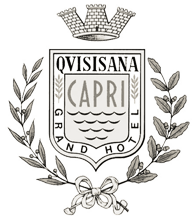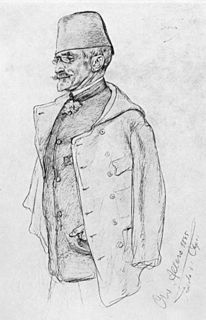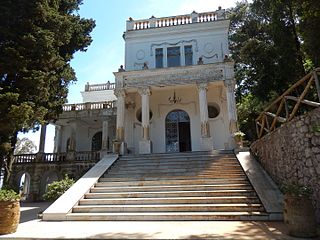
The Villa San Michele was built around the turn of the 19th century on the Isle of Capri, Italy, by the Swedish physician and author Axel Munthe.
The island of Capri is situated in the Gulf of Naples, between the Italian Peninsula and the islands of Procida and Ischia. Made of limestone, its lowest part is at the center, while its sides are high and mostly surrounded by steep precipices, which contain numerous caves. Its topography is dominated by the slopes of the Monte Solaro in the West and Mont-Saint-Michel in the East.

The Villa Medici at Careggi is a patrician villa in the hills near Florence, Tuscany, central Italy.
Edwin Cerio (1875–1960) was a prominent Italian writer, engineer, architect, historian, and botanist. He was born on the island of Capri to an English artist mother and a well-known local physician, Ignazio Cerio.

The Villa Marlia or Villa Reale di Marlia — a late-renaissance palazzo or villa, and its estate's property that includes renowned gardens and adjacent villas and follies within the compound. It is located in Capannori, in the Province of Lucca, west of Florence, in the northern Tuscany region of Italy.

Via Krupp is a historic switchback paved footpath on the island of Capri, connecting the Charterhouse of San Giacomo and the Gardens of Augustus area with Marina Piccola. Commissioned by German industrialist Friedrich Alfred Krupp, the path covers an elevation difference of about 100 m.

Marina Grande is the main port of the island of Capri in Italy, to the north of the main town of Capri and at the foot of Mount Solaro.

Marina Piccola is located on the southern side of the island of Capri. It is near the Faraglioni sea stacks to the southeast. The Via Krupp is a historic switchback paved footpath which connect the Charterhouse of San Giacomo and the Gardens of Augustus area with Marina Piccola. The Marina Piccola, used by Augustus and Tiberius, preceded the Marina Grande.
Palazzo a Mare is a well-preserved ancient Roman archaeological site on the north side of the island of Capri, consisting of an imperial palace built by Augustus and modified by Tiberius. It was one of the supposed 12 villas of Tiberius on the island as described by Tacitus along with the Villa Jovis, Villa di Gradola and Villa Damecuta. It covers a very large area on several terraces overlooking the sea.

The Gardens of Augustus, originally known by the name of Krupp Gardens, are botanical gardens on the island of Capri, Campania, Italy.

Piazza Umberto I is the most famous square of the island of Capri, Italy. The square is located in the historic center of Capri, in the eponymous town Capri, on the eastern end of the island, and since Roman times, it has been considered the center of the town and the meeting point of the island by both residents and others.

The Grand Hotel Quisisana is the largest and one of the best known hotels on the island of Capri. It is located in the heart of the old town of Capri, opposite the Hotel Residenza Capri and the Villa Sanfelice, to the south of the Piazza Umberto I. Set in gardens with "sprawling buildings [which] are painted a distinctive yellow and accented with vines," it is also a notable dining venue in the historic centre of Capri. British doctor George Sidney Clark established a sanatorium in 1845, turning it into the Grand Hotel Quisisana in 1861. "Qui si sana" means "here one heals" in Italian.

Santo Stefano is a Catholic church and former cathedral on the island of Capri, Italy. Dedicated to Saint Stephen, it is the principal house of worship in the town of Capri. The religious complex was built around the Piazza Umberto I square in the seventeenth century. The archbishop's palace is now used as the town hall ("Municipio"). Santo Stefano and Chiesa di San Costanzo are the island's two oldest churches.
Villa Solitaria was the home of the Scottish writer Compton Mackenzie when he lived on Capri, Italy. It was also used by the Scottish music critic and composer, Cecil Gray. Set on a bluff, it was built by architect Edwin Cerio in the early 20th century.

The Chiesa di San Michele Arcangelo is located in Anacapri, Capri, Italy. Located on Piazza San Nicola and built in 1719, it is octagonal in shape and of Baroque style. The church received a "monument" designation due to its notable majolica floor mosaic.
The Villa Monacone is located on the island of Capri, Italy. Situated near Pizzolungo and the Faraglioni rocks, its name derives from its location, which faces the Faraglioni's Monacone rock formation. The architectural style is unusual for a Capri villa. Built into the mountain's rocky slope, the columns and cross vaults opening by the porch connects with interior rooms rather than with the kitchen, the more common layout for a Capri villa. The German novelist, Monika Mann, lived at Villa Monacone with her friend, Antonio Spadaro, from 1954 to 1986. The Romanian historian Mircea Eliade stayed at one time in an annex of the villa.

The Chiesa di Santa Sofia is located in the Piazza of Anacapri, on the island of Capri, Italy. It dates to 1596 when it replaced Chiesa di Santa Maria di Costantinopoli as the parish church. Some of the building materials and fittings, such as the sacristy and oratorio, were originally in the Chiesa di San Carlo. The church chapels are dedicated to Sant'Antonio, Anacapri's patron saint, and the Madonna del Buon Consiglio. Architectural features include two bell towers and a baroque facade. The wedding of Guiliana DePandi and Bill Rancic occurred at the Chiesa di Santa Sofia.
Chiesa di Santa Maria del Soccorso is located within the archaeological site of Villa Jovis, on the island of Capri, Italy. It is situated on the summit of the Lo Capo hill at the eastern extremity of the island. The chapel-like church, was constructed ca. 1610. Its fittings include a bronze statue of the Madonna, a 1979 gift of the Caprese painter Guido Odierna (1913-1991). In the late 19th century, hermit lived at the church, keeping a visitor's book and selling wine.


















